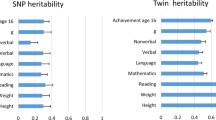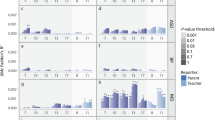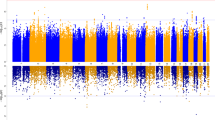Abstract
Inasmuch as the newly established DSM-oriented CBCL/6-18 scales are to be increasingly employed to assess clinical/high-risk populations, it becomes important to explore their aetiology both within the normal- and the extreme range of variation in general population samples and to compare the results obtained in different age groups. We investigated by the Quantitative Maximum Likelihood, the De Fries-Fulker, and the Ordinal Maximum Likelihood methods the genetic and environmental influences upon the five DSM-oriented CBCL/6-18 scales in 796 twins aged 8–17 years belonging to the general population-based Italian Twin Registry. When children were analysed together regardless of age, most best-fitting solutions yielded genetic and non-shared environmental factors as the sole influences for DSM-oriented CBCL/6-18 behaviours, both for the normal and the extreme variations. When analyses were conducted separately for two age groups, shared environmental influences emerged consistently for Affective and Anxiety Problems in children aged 8–11. Oppositional-Defiant, Attention Deficit/Hyperactivity, and Conduct Problems appeared—with few exceptions—influenced only by genetic and non-shared environmental factors in both age groups, according to all three computational approaches. The De Fries-Fulker method appeared to be more sensitive in detecting shared environmental effects. Analysing the same set of data with different analytic approaches leads to better-balanced views on the aetiology of psychopathological behaviours in the developmental years.

Similar content being viewed by others
References
Achenbach TM, Dumenci L, Rescorla LA (2003) DSM-oriented and empirically based approaches to constructing scales from the same item pools. J Clin Child Adolesc Psychol 32:328–340
Achenbach TM, Rescorla LA (2001) Manual for the ASEBA school-age forms & profiles. ASEBA, Burlington, VT: University of Vermont, Research
Achenbach TM, Verhulst FC, Baron GD, Althaus M (1987) A comparison of syndromes derived from the Child Behavior Checklist for American and Dutch boys aged 6–11 and 12–16. J Child Psychol Psychiatry 28:437–453
Battaglia M, Pesenti-Gritti P, Medland SE, Ogliari A, Tambs K, Spatola CA (2009) A genetically informed study of the association between childhood separation anxiety, sensitivity to CO2, panic disorder, and the effect of childhood parental loss. Arch Gen Psychiatry 66:64–71
Boomsma DI, Rebollo I, Derks EM, van Beijsterveldt TC, Althoff RR, Rettew DC, Hudziak JJ (2006) Longitudinal stability of the CBCL-juvenile bipolar disorder phenotype: a study in Dutch twins. Biol Psychiatry 60:912–920
Boomsma DI, van Beijsterveldt CE, Hudziak JJ (2005) Genetic and environmental influences on Anxious/Depression during childhood: a study from the Netherlands Twin Register. Genes Brain Behav 4:466–481
Carter AS, Grigorenko EL, Pauls DL (1995) A Russian adaptation of the Child Behavior Checklist: psychometric properties and associations with child and maternal affective symptomatology and family function. J Abnorm Child Psychol 23:661–684
Cherny SS, DeFries JC, Fulker DW (1992) Multiple regression analysis of twin data: a model-fitting approach. Behav Genet 22:489–497
Crijnen AA, Achenbach TM, Verhulst FC (1999) Problems reported by parents of children in multiple cultures: the Child Behavior Checklist syndrome constructs. Am J Psychiatry 156:569–574
Deater-Deckard K, Reiss D, Hetherington EM, Plomin R (1997) Dimensions and disorders of adolescent adjustment: a quantitative genetic analysis of unselected samples and selected extremes. J Child Psychol Psychiatry 38:515–525
DeFries JC, Fulker DW (1985) Multiple regression analysis of twin data. Behav Genet 15:467–473
Derks EM, Dolan CV, Boomsma DI (2004) Effects of censoring on parameter estimates and power in genetic modeling. Twin Res 7:659–669
Derks EM, Hudziak JJ, Dolan CV, van Beijsterveldt TC, Verhulst FC, Boomsma DI (2008) Genetic and environmental influences on the relation between attention problems and attention deficit hyperactivity disorder. Behav Genet 38:11–23
Dunn J, O’Connor TG, Levy I (2002) Out of the picture: a study of family drawings by children from step-, single-parent, and non-step families. J Clin Child Adolesc Psychol 31:505–512
Eley TC (1997) Depressive symptoms in children and adolescents: etiological links between normality and abnormality: a research note. J Child Psychol Psychiatry 38:861–865
Evans DM, Gillespie NA, Martin NG (2002) Biometrical genetics. Biol Psychol 61:33–51
Faraone SV, Althoff RR, Hudziak JJ, Monuteaux M, Biederman J (2005) The CBCL predicts DSM bipolar disorder in children: a receiver operating characteristic curve analysis. Bipolar Disord 7:518–524
Ferdinand RF (2008) Validity of the CBCL/YSR DSM-IV scales Anxiety Problems and Affective Problems. J Anxiety Disord 22:126–134
Frigerio A, Cattaneo C, Cataldo MG, Schiatti A, Molteni M, Battaglia M (2004) Behavioral and emotional problems among Italian children and adolescents aged 4 to 18 years as reported by parents and teachers. Eur J Psychol Assess 20:124–133
Gjone H, Stevenson J, Sundet JM, Eilertsen DE (1996) Changes in heritability across increasing levels of behavior problems in young twins. Behav Genet 26:419–426
Goldsmith HH (1991) A zygosity questionnaire for young twins: a research note. Behav Genet 21:257–269
Heath AC, Neale MC, Hewitt JK, Eaves LJ, Fulker DW (1989) Testing structural equation models for twin data using LISREL. Behav Genet 19:9–35
Hudziak JJ, Althoff RR, Derks EM, Faraone SV, Boomsma DI (2005) Prevalence and genetic architecture of Child Behavior Checklist-juvenile bipolar disorder. Biol Psychiatry 58:562–568
Hudziak JJ, Derks EM, Althoff RR, Rettew DC, Boomsma DI (2005) The genetic and environmental contributions to attention deficit hyperactivity disorder as measured by the Conners’ Rating Scales–Revised. Am J Psychiatry 162:1614–1620
Hudziak JJ, van Beijsterveldt CE, Bartels M, Rietveld MJ, Rettew DC, Derks EM, Boomsma DI (2003) Individual differences in aggression: genetic analyses by age, gender, and informant in 3-, 7-, and 10-year-old Dutch twins. Behav Genet 33:575–589
ISTAT (2003) Rapporto Annuale 2002 Roma: Istituto Nazionale di statistica
Kohler HP, Rodgers JL (2001) DF-analyses of heritability with double-entry twin data: asymptotic standard errors and efficient estimation. Behav Genet 31:179–191
Krol NP, De Bruyn EE, Coolen JC, van Aarle EJ (2006) From CBCL to DSM: a comparison of two methods to screen for DSM-IV diagnoses using CBCL data. J Clin Child Adolesc Psychol 35:127–135
Legrand LN, McGue M, Iacono WG (1999) A twin study of state and trait anxiety in childhood and adolescence. J Child Psychol Psychiatry 40:953–958
Lengua LJ, Sadowski CA (2001) Assessing the child psychopathology beast: a reply to Achenbach and Dumenci’s (2001) commentary. J Consult Clin Psychol 69:703–705
Neale MC, Boker SM, Xie G, Maes H (2003) Mx: Statistical Modeling. Department of Psychiatry, Virginia Commonwealth, Richmond
Neale MC, Cardon LR (1992) Methodology for genetic studies of twins and families. Kluwer, Dordrecht, The Netherlands
Nobile M, Rusconi M, Bellina M, Marino C, Giorda R, Carlet O, Vanzin L, Molteni M, Battaglia M (2009) The influence of family structure, the TPH2 G-703T and the 5-HTTLPR serotonergic genes upon affective problems in children aged 10–14 years. J Child Psychol Psychiatry 50:317–325
Novik TS (1999) Validity of the child behaviour checklist in a Norwegian sample. Eur Child Adolesc Psychiatry 8:247–254
Ogliari A, Citterio A, Zanoni A, Fagnani C, Patriarca V, Cirrincione R, Stazi MA, Battaglia M (2006) Genetic and environmental influences on anxiety dimensions in Italian twins evaluated with the SCARED questionnaire. J Anxiety Disord 20:760–777
Pesenti-Gritti P, Spatola CA, Fagnani C, Ogliari A, Patriarca V, Stazi MA, Battaglia M (2008) The co-occurrence between internalizing and externalizing behaviors. A general population twin study. Eur Child Adolesc Psychiatry 17:82–92
Purcell S, Eley TC, Dale PS, Oliver B, Petrill SA, Price TS, Saudino KJ, Simonoff E, Stevenson J, Taylor E, Plomin R (2001) Comorbidity between verbal and non-verbal cognitive delays in 2-year-old: a bivariate twin analysis. 4:195-196-208
Purcell S, Sham PC (2003) A model-fitting implementation of the DeFries-Fulker model for selected twin data. Behav Genet 33:271–278
Reich T, James JW, Morris CA (1972) The use of multiple thresholds in determining the mode of transmission of semi-continuous traits. Ann Hum Genet 36:163–184
Rende R (1999) Adaptive and maladaptive pathways in development: a quantitative genetic perspective. In: La Buda M, Grigorenko EL, Ravich-Serbo I, Scarr S (eds) On the way to individuality: current methodological issues in behavioral genetics. Nova Science, New York
Rende R, Slomkowski C, Lloyd-Richardson E, Niaura R (2005) Sibling effects on substance use in adolescence: social contagion and genetic relatedness. J Fam Psychol 19:611–618
Rende R, Slomkowski C, Lloyd-Richardson E, Stroud L, Niaura R (2006) Estimating genetic and environmental influences on depressive symptoms in adolescence: differing effects on higher and lower levels of symptoms. J Clin Child Adolesc Psychol 35:237–243
Rende RD, Plomin R, Reiss D, Hetherington EM (1993) Genetic and environmental influences on depressive symptomatology in adolescence: individual differences and extreme scores. J Child Psychol Psychiatry 34:1387–1398
Rice F, Harold G, Thapar A (2002) The genetic aetiology of childhood depression: a review. J Child Psychol Psychiatry 43:65–79
Rietveld MJ, Hudziak JJ, Bartels M, van Beijsterveldt CE, Boomsma DI (2004) Heritability of attention problems in children: longitudinal results from a study of twins, age 3 to 12. J Child Psychol Psychiatry 45:577–588
Salbach-Andrae H, Klinkowski N, Lenz K, Lehmkuhl U (2009) Agreement between youth-reported and parent-reported psychopathology in a referred sample. Eur Child Adolesc Psychiatry 18:136–143
Seiffge-Krenke I, Kollmar F (1998) Discrepancies between mothers’ and fathers’ perceptions of sons’ and daughters’ problem behaviour: a longitudinal analysis of parent-adolescent agreement on internalising and externalising problem behaviour. J Child Psychol Psychiatry 39:687–697
Silberg JL, Erickson MT, Meyer JM, Eaves LJ, Rutter ML, Hewitt JK (1994) The application of structural equation modeling to maternal ratings of twins’ behavioral and emotional problems. J Consult Clin Psychol 62:510–521
Spatola CA, Fagnani C, Pesenti-Gritti P, Ogliari A, Stazi MA, Battaglia M (2007) A general population twin study of the CBCL/6–18 DSM-oriented scales. J Am Acad Child Adolesc Psychiatry 46:619–627
Stazi MA, Cotichini R, Patriarca V, Brescianini S, Fagnani C, D’Ippolito C, Cannoni S, Ristori G, Salvetti M (2002) The Italian Twin Project: from the personal identification number to a national twin registry. Twin Res 5:382–386
Taylor E (2009) Developing ADHD. J Child Psychol Psychiatry 50:126–132
Thapar A, McGuffin P (1994) A twin study of depressive symptoms in childhood. Br J Psychiatry 165:259–265
van Beijsterveldt CE, Bartels M, Hudziak JJ, Boomsma DI (2003) Causes of stability of aggression from early childhood to adolescence: a longitudinal genetic analysis in Dutch twins. Behav Genet 33:591–605
van Beijsterveldt CE, Verhulst FC, Molenaar PC, Boomsma DI (2004) The genetic basis of problem behavior in 5-year-old dutch twin pairs. Behav Genet 34:229–242
van den Oord EJ, Pickles A, Waldman ID (2003) Normal variation and abnormality: an empirical study of the liability distributions underlying depression and delinquency. J Child Psychol Psychiatry 44:180–192
van der Bruggen CO, Stams GJ, Bogels SM (2008) Research review: the relation between child and parent anxiety and parental control: a meta-analytic review. J Child Psychol Psychiatry 49:1257–1269
van der Valk JC, Verhulst FC, Stroet TM, Boomsma DI (1998) Quantitative genetic analysis of internalising and externalising problems in a large sample of 3-year-old twins. Twin Res 1:25–33
Waller NG (1994) A DeFries and Fulker regression model for genetic nonadditivity. Behav Genet 24:149–153
Yang HJ, Soong WT, Chiang CN, Chen WJ (2000) Competence and behavioral/emotional problems among Taiwanese adolescents as reported by parents and teachers. J Am Acad Child Adolesc Psychiatry 39:232–239
Acknowledgments
Supported in part by the Italian Ministry of Health (project no. OAB/F/2000 grant BO16.1 and Strategic Research Grant 2009 ‘Early Identification and Prevention in Childhood and Adolescence Mental Health’; MB Principal Investigator) and the Italian Ministry of University (grant 2006.061953_001 MB Principal Investigator). The first author of this paper is in the San Raffaele University Developmental Psychopathology Ph D Program, supported in part by the CARIPLO Foundation ‘Human Talents’ Grant for Academic Centres of Excellence in Post-Graduate Teaching (MB Recipient). The assistance of Paola Pesenti-Gritti M Sc in data analyses is gratefully acknowledged.
Author information
Authors and Affiliations
Corresponding author
Rights and permissions
About this article
Cite this article
Spatola, C.A.M., Rende, R. & Battaglia, M. Genetic and environmental influences upon the CBCL/6-18 DSM-oriented scales: similarities and differences across three different computational approaches and two age ranges. Eur Child Adolesc Psychiatry 19, 647–658 (2010). https://doi.org/10.1007/s00787-010-0102-z
Received:
Accepted:
Published:
Issue Date:
DOI: https://doi.org/10.1007/s00787-010-0102-z




